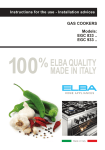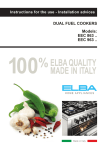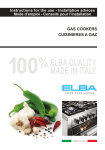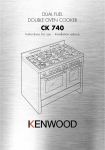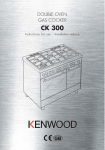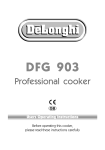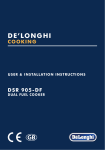Download Elba EGC 533 CM Product data
Transcript
Instructions for the use - Installation advices GAS COOKERS Models: EGC 533 WH, EGC 533 CM, EGC 533 LG % ELBA QUALITY 100 MADE IN ITALY HOME APPLIANCES Made in Italy Dear Customer, Thank you for having purchased and given your preference to our product. The safety precautions and recommendations reported below are for your own safety and that of others. They will also provide a means by which to make full use of the features offered by your appliance. Please preserve this booklet carefully. It may be useful in future, either to yourself or to others in the event that doubts should arise relating to its operation. This appliance must be used only for the task it has explicitly been designed for, that is for cooking foodstuffs. Any other form of usage is to be considered as inappropriate and therefore dangerous. The manufacturer declines all responsibility in the event of damage caused by improper, incorrect or illogical use of the appliance. 2 IMPORTANT SAFETY PRECAUTIONS AND RECOMMENDATIONS IMPORTANT: This appliance is designed and manufactured solely for the cooking of domestic (household) food and is not suitable for any non domestic application and therefore should not be used in a commercial environment. The appliance guarantee will be void if the appliance is used within a non domestic environment i.e. a semi commercial, commercial or communal environment. Read the instructions carefully before installing and using the appliance. • After having unpacked the appliance, check to ensure that it is not damaged and that the oven door closes correctly. In case of doubt, do not use it and consult your supplier or a professionally qualified technician. • Packing elements (i.e. plastic bags, polystyrene foam, nails, packing straps, etc.) should not be left around within easy reach of children, as these may cause serious injuries. • Some appliances are supplied with a protective film on steel and aluminium parts. This film must be removed before using the appliance. • IMPORTANT: The use of suitable protective clothing/gloves is recommended when handling or cleaning this appliance. • Do not attempt to modify the technical characteristics of the appliance as this may become dangerous to use. The manufacturer declines all responsibility for any inconvenience resulting from the inobservance of this condition. • CAUTION: this appIiance must only be installed in a permanently ventilated room in compliance with the applicable regulations. • Do not use a steam cleaner because the moisture can get into the appliance thus make it unsafe. • If you should decide not to use this appliance any longer (or decide to substitute another model), before disposing of it, it is recommended that it be made inoperative in an appropriate 3 • • • • • • • • • 4 manner in accordance to health and environmental protection regulations, ensuring in particular that all potentially hazardous parts be made harmless, especially in relation to children who could play with unused appliances. The various components of the appliance are recyclable. Dispose of them in accordance with the regulations in force in your country. After use, ensure that the knobs are in the off position. Children less than 8 years of age shall be kept away unless continuously supervised. This appliance can be used by children aged from 8 years and above and persons with reduced physical, sensory or mental capabilities or lack of experience and knowledge if they have been given supervision or instruction concerning use of the appliance in a safe way and understand the hazards involved. Children shall not play with the appliance. Cleaning and user maintenance shall not be made by children without supervision. The manufacturer declines all liability for injury to persons or damage to property caused by incorrect or improper use of the appliance. WARNING: During use the appliance and its accessible parts become hot; they remain hot for some time after use. –– Care should be taken to avoid touching heating elements (on the hob and inside the oven). –– The door is hot, use the handle. –– To avoid burns and scalds, young children should be kept away. Make sure that electrical cables connecting other appliances in the proximity of the cooker cannot come into contact with the hob or become entrapped in the oven door. WARNING: Unattended cooking on a hob with fat or oil can be dangerous and may result in fire. NEVER try to extinguish a fire with water, but switch off the appliance and then cover flame e.g. with a lid or a fire blanket. WARNING: Danger of fire: do not store items on the cooking surfaces. • WARNING: When correctly installed, your product meets all safety requirements laid down for this type of product category. However special care should be taken around the rear or the underneath of the appliance as these areas are not designed or intended to be touched and may contain sharp or rough edges, that may cause injury. • FIRST USE OF THE OVEN - it is advised to follow these instructions: –– Furnish the interior of the oven as described in the chapter “CLEANING AND MAINTENANCE”. –– Switch on the empty oven on max to eliminate grease from the heating element. –– Let the oven cool down and clean the interior of the oven with a cloth soaked in water and neutral detergent; then dry carefully. • CAUTION: Do not use harsh abrasive cleaners or sharp metal scrapers to clean the oven door glass since they can scratch the surface, which may result in shattering of the glass. • Do not line the oven walls with aluminium foil. Do not place baking trays or the drip tray on the base of the oven chamber. • FIRE RISK! Do not store flammable material in the oven. • Always use oven gloves when removing the shelves and food trays from the oven whilst hot. • Do not hang towels, dishcloths or other items on the appliance or its handle – as this could be a fire hazard. • Clean the oven regularly and do not allow fat or oils to build up in the oven base or tray. Remove spillages as soon as they occur. • Do not stand on the cooker or on the open oven door. • Always stand back from the appliance when opening the oven door to allow steam and hot air to escape before removing the food. • SAFE FOOD HANDLING: Leave food in the oven for as short a time as possible before and after cooking. This is to avoid contamination by organisms which may cause food poisoning. Take particular care during warmer weather. • WARNING: Take care NOT to lift the cooker by the door handle. 5 1 COOKING HOB Fig. 1.1 3 3 GAS BURNERS 1,00 kW 2. Rapid burner (R) 3,00 kW 3. Semi-rapid burner (SR) 1,75 kW 2 1 2 1. Auxiliary burner (A) CONTROL PANEL Fig. 2.1 5 4 3 2 CONTROLS DESCRIPTION 1. Rear right burner control knob 2. Front right burner control knob 3. Front left burner control knob 4. Rear left burner control knob 5. Gas oven control knob 6. Gas burners electronic igniter pushbutton (cooktop burners only) 6 1 6 3 USE OF THE HOB BURNERS Each burner is controlled by a gas tap (fig. 3.1) assuring the opening and the closing of the gas supply. Make the knob symbols match with the indicator on the control panel to obtain: • symbol : off • symbol : full on (nominal rate) • symbol : reduced rate √√ √√ √√ The maximum aperture position permits rapid boiling of liquids, whereas the minimum aperture position allows slower warming of food or maintaining boiling conditions of liquids. Fig. 3.1 To reduce the gas flow to minimum, rotate the knob further anti-clockwise to point the indicator towards the small flame symbol. Other intermediate operating adjustments can be achieved by positioning the indicator between the maximum and minimum aperture positions, and never between the maximum aperture and closed positions. Fig. 3.2 In the event of the burner flames being accidentally extinguished, turn off the burner control and do not attempt to re-ignite the burner for at least 1 min. N.B. When the cooker is not being used, set the gas knobs to their closed positions and also close the cock valve on the gas bottle or the main gas supply line. Caution! The cooking hob becomes very hot during operation. Keep children well out of reach. 7 LIGHTING THE BURNERS CHOICE OF THE BURNER To ignite the burner, the following instructions are to be followed: On the control panel, near every knob, there is a diagram that indicates which burner is controlled by that knob. 1. Press in the corresponding knob and turn counter-clockwise (fig. 3.2 ) to the full flame position marked by the (full on) symbol (fig. 3.1). 2. Press the ignition button marked by the symbol (fig. 3.3). The sparks produced by the electrodes situated next to the burner will light the selected burner. In the case of a mains failure light the burner with a match or lighted taper. As an indication, the burners and the pots must be used in the following way: DIAMETERS OF PANS WHICH MAY BE USED ON THE BURNERS BURNERS MINIMUM MAXIMUM Auxliliary 12 cm 14 cm 3. Adjust the gas valve to the desired position. Semi-rapid 16 cm 24 cm Rapid 24 cm 26 cm To turn it off, turn the knob towards the right, up to the safety click. Wok pan If your local gas supply makes it difficult to light the burner with the knob set to maximum, set the knob to minimum and repeat the operation. BATTERY IGNITION If the electronic ignition does not work make sure that the battery, installed on the back of the cooker, is not flat and has been installed correctly (see the chapter “Battery installation”, page 26). Fig. 3.3 8 The suitable burner must be chosen according to the diameter and the capacity used. Max 36 cm do not use pans with concave or convex bases It is important that the diameter of the pot be suitable to the potentiality of the burner so as not to compromise the high output of the burners and therefore energy waste. A small pot on a large burner does not give you a boiling point in a shorten amount of time since the capacity of heat absorption of a liquid mass depends on the volume and the surface of the pot. Fig. 3.4 CORRECT USE OF THE RAPID BURNER The flat-bottomed pans are to be placed directly onto the pan-support. When using a WOK you need to place the supplied stand in the burner to avoid any faulty operation of the rapid burner (Fig. 3.5a - 3.5b). IMPORTANT: The special grille for wok pans (fig. 3.5b) MUST BE PLACED ONLY over the pan-rest for the rapid burner. WRONG CORRECT Fig. 3.5a Fig. 3.5b 9 4 USE OF THE GAS OVEN The glass on the oven door reaches high temperatures during operation. Keep children away. The cooker lid must be kept open when the gas oven is in use. WARNING: The door is hot, use the handle. OVEN DOOR GUARD The glass on the oven door reaches high temperatures during operation. For child safety, a door guard can be fitted to prevent contact with the hot glass. The door guard (thermoreflective door inner glass) is supplied as an accessory at extra cost, if required. Contact the After-Sales Service and indicate the model name of your product (see product data plate). GENERAL FEATURES The oven is furnished completely clean; it is advisable however, upon first use, to turn the oven on to the maximum temperature (position 10) to eliminate possible traces of grease from the oven burner. THERMOSTAT The numbers 1 to 10 printed on the knob (fig. 4.1) indicate the increasing oven temperature value (see table 4.2). To regulate the temperature, make the chosen number of the knob (fig. 4.1) match with the indicator on the control panel. The temperature is kept constant on the regulated value. The thermostat which regulates the flow of gas to the oven burner has a safety valve which automatically shuts off the gas supply when the flame goes out. OVEN BURNER It carries out normal “oven cooking”. The gas flow to the burner is regulated by a thermostat which allow to maintain the oven temperature constant. The control of the temperature is assured by a thermostatic probe positioned inside the oven. The probe must be always kept in its housing, in a clean condition, as an incorrect position or encrustment may cause an alteration in the control of the temperature. The gas oven is provided with: • One gas burner (wattage: 3,20 kW), located at the bottom, providing safety valve device. 1 2 3 0 1 4 6 7 8 9 10 5 Fig. 4.1 Table. 4.2 IGNITION OF THE OVEN BURNER COOKING EXAMPLES ATTENTION: Never turn the control knob before opening the oven door. Temperatures are approximate as they vary depending on the quality and amount of food. Remember to use ovenproof dishes and to adjust the oven temperature during cooking if necessary. To ignite the oven burner: 1. Open the oven door to the full extent. WARNING: Risk of explosion! The oven door must be open during this operation. 2. Approach a flame to the hole ‘A’ of the oven floor (fig. 4.3) before turning the gas thermostat. 3. Press in the oven control knob and turn counter-clockwise (fig. 4.4) to position 10. Never turn the gas thermostat before approaching a flame to the hole “A” of the floor. Never continue this operation for more than 15 seconds. If the burner has still not ignited, wait for about 1 minute prior to repeating the ignition. 4. Check that the burner has lit; if not, turn the knob clockwise back to “ ” (OFF) and repeat the procedure from step 2. 5. Gently close the oven door and set the oven control knob to the required temperature. If the flame extinguishes for any reason, the safety valve will automatically shut off the gas supply to the burner. To re-light the burner, first turn the oven control knob to position “ ” (OFF), wait for at least 1 minute and then repeat the lighting procedure. DISHES TEMPERATURE Lasagne Baked pasta Pizza Creole rice Baked onions Spinach crêpes Potatoes baked in milk Stuffed tomateos Cheese soufflé Roast veal Grilled veal chops Chicken breasts with tomato Grilled chicken - roast chicken Veal loaf Roast beef Fillet of sole Aromatic hake Beignets Ring cake Plum tart Jam tartlets Sponge cake Sweet dough Sweet puffs Plain sponge cake 190°C 190°C 220°C 190°C 190°C 185°C 185°C 180°C 170°C 180°C 210°C 180°C 190°C 175°C 170°C 175°C 170°C 160°C 150°C 170°C 160°C 170°C 160°C 170°C 170°C A Fig. 4.3 Fig. 4.4 11 5 CLEANING AND MAINTENANCE GENERAL ADVICE ENAMELLED PARTS • When the appliance is not being used, it is advisable to keep the gas tap closed. • The periodical lubrication of the gas taps must be done only by specialized personnel. • If a tap becomes stiff, do not force; contact your local After Sales Service Centre. All the enamelled parts must be cleaned with a sponge and soapy water or other non-abrasive products. Dry preferably with a microfibre or soft cloth. Acidic substances like lemon juice, tomato sauce, vinegar etc. can damage the enamel if left too long. • It is advisable to clean when the appliance is cold and especially when cleaning the enamelled parts. • Avoid leaving alkaline or acidic substances (lemon juice, vinegar, etc.) on the surfaces. • Avoid using cleaning products with a chlorine or acidic base. • Important: The use of suitable protective clothing/gloves is recommended when handling or cleaning of this appliance. WARNING When correctly installed, your product meets all safety requirements laid down for this type of product category. However special care should be taken around the rear or the underneath of the appliance as these areas are not designed or intended to be touched and may contain sharp or rough edges, that may cause injury. STAINLESS STEEL, ALUMINIUM PARTS, PAINTED AND SILK-SCREEN PRINTED SURFACES Clean using an appropriate product. Always dry thoroughly. IMPORTANT: these parts must be cleaned very carefully to avoid scratching and abrasion. You are advised to use a soft cloth and neutral soap. CAUTION: Do not use abrasive substances or non-neutral detergents as these will irreparably damage the surface. OVEN DOOR The internal glass of the oven door can be easily removed for cleaning by unscrewing the two lateral fixing screws (fig. 5.1). Fig. 5.1 Attention! The appliance gets very hot, mainly around the cooking areas. It is very important that children are not left alone in the kitchen when you are cooking. Do not use a steam cleaner because the moisture can get into the appliance thus make it unsafe. Do not use harsh abrasive cleaners or sharp metal scrapers to clean the oven door glass since they can scratch the surface, which may result in shattering of the glass. 12 GAS TAPS BURNERS Periodic lubrication of the gas taps must be carried out by specialist personnel only. In the event of operating faults in the gas taps, call the Service Department. They can be removed and washed with soapy water only. They will remain always perfect if cleaned with products used for silverware. After cleaning or wash, check that burnercaps and burner-heads are dry before placing them in the respective housings. INSIDE OF OVEN The oven should always be cleaned after use when it has cooled down. The cavity should be cleaned using a mild detergent solution and warm water. Suitable proprietary chemical cleaners may be used after first consulting with the manufacturers recommendations and testing a small sample of the oven cavity. Abrasive cleaning agents or scouring pads/ cloths should not be used on the cavity surface. NOTE: The manufacturers of this appliance will accept no responsibility for damage caused by chemical or abrasive cleaning. Let the oven cool down and pay special attention no to touch the hot heating element inside the oven cavity. Fire risk! Do not store flammable material in the oven. Check that the electrode S (fig. 5.1) next to each burner is always clean to ensure trouble-free sparking. Note: The electrode “S” must be very carefully cleaned. To avoid damage to the electric ignition do not use it when the burners are not in place. CORRECT REPLACEMENT OF THE BURNERS It is very important to check that the burner flame distributor “F” and the cap “C” has been correctly positioned (see figs. 5.25.3) - failure to do so can cause serious problems. C F S Fig. 5.2 Fig. 5.3 13 Advice for the installer IMPORTANT 14 • Cooker installation must only be carried out by QUALIFIED TECHNICIANS and in compliance with local safety standards. Failure to install the appliance correctly could invalidate any manufacturer’s warranty. • The appliance must be installed in compliance with regulations in force in your country and in observation of the manufacturer’s instructions. • Some appliances are supplied with a protective film on steel and aluminium parts. This film must be removed before using the cooker. 6 INSTALLATION The cooker affords class “1” protection against overheating of surrounding surfaces. The installation conditions, concerning protection against overheating of the surfaces adjacent to the cooker, must conform to Figs. 6.1 and 6.2. A space of at least 2 cm must be left between the cooker and any adjacent furniture, which must not exceed the height of the cooktop. If the cooker is installed adjacent to furniture which is higher than the gas hob cooktop, a gap of at least 30 cm must be left between the side of the cooker and the furniture. The veneered syntetical material and the glue used must be resistant to a temperature of 90°C in order to avoid ungluing or deformations. Curtains must not be fitted immediatly behind appliance or within 500 mm of the sides. If the cooker is located on a pedestal it is necessary to provide safety measures to prevent falling out. The appliance must be housed in heat resistant units. The walls of the units must not be higher than work top and must be capable of resisting temperatures of 75 °C above room temperature. Do not instal the appliance near inflammable materials (eg. curtains). ■■ Class 1 450 mm 650 mm Gas connection made using rubber hose which must be visible and easily inspected or using rigid or flexible metal pipe. 500 mm 300 mm 50 cm 20 mm 20 mm Fig. 6.1 Fig. 6.2 15 cm VENTILATION REQUIREMENTS The appliance must be installed in compliance with applicable local regulations concerning ventilation and the evacuation of exhaust gases. Intensive and prolonged use may require extra ventilation, e.g. opening a window, or more efficient ventilation increasing the mechanical suction power if this is fitted. CHOOSING SUITABLE SURROUNDINGS The room where the gas appliance is to be installed must have a natural flow of air so that the gas can burn (in compliance with applicable local regulations). The flow of air must come directly from one or more openings made in the outside walls with a free area of at least 200 cm2 (or refer to applicable local regulations). The openings should be near the floor and preferably on the side opposite the exhaust for combustion products and must be so made that they cannot be blocked from either the outside or the outside. When these openings cannot be made, the necessary air can come from an adjacent room which is ventilated as required, as long as it is not a bed room or a danger area (in compliance with applicable local regulations). In this case, the kitchen door must allow the passage of the air. DISCHARGING PRODUCTS OF COMBUSTION Extractor hoods connected directly to the outside must be provided, to allow the products of combustion of the gas appliance to be discharged (Fig. 6.3). If this is not possible, an electric fan may be used, attached to the external wall or the window; the fan should have a capacity to circulate air at an hourly rate of 3-5 times the total volume of the kitchen (Fig. 6.4). The fan can only be installed if the room has suitable vents to allow air to enter, as described under the heading “Choosing suitable surroundings”. H min 650 mm Extractor hood for products of combustion Electric fan to extract products of combustion Air vent Fig. 6.3 16 Air vent Fig. 6.4 7 GAS SECTION GAS INSTALLATION REQUIREMENTS Important ! • The walls adjacent to the cooker must be of heat-resistant material. • Before installation, make sure that the local distribution conditions (gas type and pressure) and the adjustment of this appliance are compatible. The appliance adjustment conditions are given on the plate or the label. • This appliance must be installed and serviced only by a suitably qualified, registered installer. The installer shall refer to the local standards in force. • Failure to install the appliance correctly could invalidate any manufacturer’s warranty. This appliance is supplied for use on Natural gas, LPG or Town Gas (check the gas regulation label attached on the appliance). • • • Appliances supplied for use on Natural gas: they are adjusted for this gas only and cannot be used on any other gas (LPG or Town gas) without modification. The appliances are manufactured for conversion to LPG and Town gas. Appliances supplied for use on LPG: they are adjusted for this gas only and cannot be used on any other gas (Natural or Town gas) without modification. The appliances are manufactured for conversion to Natural and Town gas. Appliances supplied for use on Town gas: they are adjusted for this gas only and cannot be used on any other gas (Natural gas or LPG) without modification. The appliances are manufactured for conversion to Natural gas and LPG. If the Natural gas/LPG/Town gas conversion kit is not supplied with the appliance this kit can be purchased by contacting the After-Sales Service. CONNECTING THE APPLIANCE TO THE GAS SUPPLY The gas connection must be carried out by an authorised person according to the relevant standards. Ensure that the room in which the cooker is to be installed is adequately ventilated, in compliance with applicable regulations. • Connect the cooker to the gas mains utilizing rigid or flexible pipes. • The gas supply is connected at the rear of the cooker to the terminal of the gas inlet pipe (Fig. 7.1). The connection pipe must not cross the rear of the appliance. 17 Fig. 7.1 ok ok THE PIPE DOES NOT CROSS THE REAR PANEL OF THE COOKER. IN CASE OF CROSSING THE BACK PANEL, ENSURE THE PIPE IS POSITIONED CLOSE TO THE BOTTOM PART OF THE APPLIANCE. POSSIBLE GAS CONNECTIONS GAS CONNECTION WITH A RUBBER HOSE Important! A rubber hose connection shall only be made if permitted by the applicable local regulations. The gas connection is made up of: • the terminal fitting of the inlet pipe; • the brass connector; • sealing washer/s; • the appropriate hose holder (for Natural/Town gas or LPG). Important! If the brass connector is not already fitted on the appliance (but supplied in a separate kit), screw that connector to the terminal of the gas inlet pipe before starting the connection to the gas supply. Use two spanners when connecting the brass connector. Connecting the cooker to Natural or Town gas 1. If not already fitted, fit the Natural/Town gas hose holder on the inlet pipe, making sure that you place the sealing washer between them (as shown in Fig. 7.2). 2. Connect the cooker to the gas supply using a suitable rubber hose (internal diameter 13 mm). The hose must comply with the applicable local regulations and be of the correct construction for the type of gas being used. 18 3. Make sure that the hose is tightly and securely fitted at both ends. 4. Use a standard hose clamp (not supplied) to fasten the hose. Connecting the cooker to LPG 1. If not already fitted, fit the LPG hose holder on the inlet pipe, making sure that you place the sealing washer between them (as shown in Fig. 7.2). Important! The LPG hose holder is composed by Natural/Town gas hose holder with LPG hose adapter screwed at the bottom end (interposing the proper sealing washer between them). 2. Connect the cooker to the gas supply using a suitable rubber hose (internal diameter 8 mm). The hose must comply with the applicable local regulations and be of the correct construction for the type of gas being used. 3. Make sure that the hose is tightly and securely fitted at both ends. 4. Use a standard hose clamp (not supplied) to fasten the hose. 5. Install a gas pressure regulator. Important! To comply with applicable local regulations, a gas pressure regulator (conforming to the local regulations in force) must be installed when connecting the cooker to an LPG cylinder. When connecting the cooker to the gas supply with a rubber hose, make sure that • the hose is as short as possible, without twists or kinks. • the hose is not longer than 750 mm (or refer to applicable local regulations) and does not come into contact with sharp edges, corners or moving parts. Use a single rubber hose only; never connect the appliance with more than one rubber hose. • the hose is not under tension, twisted, kinked, or too tightly bent, neither while the appliance is in use nor while it is being connected or disconnected. • the hose does not come into contact with any part of the cooker with a surface temperature of 70°C or above (or refer to applicable local regulations). • the hose is not subject to excessive heat by direct exposure to flue products or by contact with hot surfaces. • the hose can easily be inspected along its entire length to check its condition. • the hose is replaced at the printed due date or if it shows signs of wear or damage, and replaced regardless of its condition after a maximum of three years. • you inform the customer that the gas cylinder valve or the gas supply valve immediately by the cooker should be closed when the cooker is not in use. • you inform the customer that the hose should not be subjected to corrosion by acidic cleaning agents. After connecting the cooker to the gas supply, make sure that you • check that the connections are correctly sealed using a soapy solution, but never a naked flame. • check whether the injectors are correct for the type of gas being used. If not, follow the instructions under “GAS MAINTENANCE”. • replace the sealing washer/s on the slightest sign of deformation or imperfection. The sealing washer/s is/are the part/s which guarantees a good seal in the gas connection. • use two spanners when fitting the parts (Fig. 7.2). 19 Gas connection with rubber hose holders Note: if not already fitted on the inlet pipe, the hose holders are supplied with the product in a separate kit. Inlet pipe Manifold male pipe fitting 1/2” G cylindrical (ISO 228-1) male Sealing washer (#) 1/2” G cylindrical (ISO 228-1) female Brass connector (#) 1/2” G cylindrical (ISO 228-1) male Sealing washer (#) 1/2” G cylindrical (ISO 228-1) female Hose holder for Natural/Town gas (#) If not already fitted on the inlet pipe, it is supplied with the appliance in a separate kit 1/2” G cylindrical (ISO 228-1) female Hose holder for Natural/Town gas LPG hose adapter sealing washer Hose clamp (not supplied) Hose adapter for LPG Hose clamp (not supplied) Rubber hose (not supplied) for LPG connection (internal diameter 8 mm) LPG Rubber hose (not supplied) for Natural/Town gas connection (internal diameter 13 mm) Natural or Town gas Fig. 7.2 GAS CONNECTION WITH RIGID PIPES OR A FLEXIBLE PIPE The gas connection is made up of: • the terminal fitting of the inlet pipe; • the brass connector; • sealing washers. Important! ■■ ■■ If fitted, remove the hose holder from the terminal fitting of the inlet pipe. If the brass connector is not already fitted on the appliance (but supplied in a separate kit), screw that connector to the terminal of the gas inlet pipe before starting the connection to the gas supply. Use two spanners when connecting the brass connector. When connecting the cooker to the gas supply with rigid pipes or a flexible pipe, make sure that • you use rigid pipes or a flexible pipe complying with applicable local regulations. The flexible pipe shall be of the correct construction for the type of gas being used. • if compression fittings are used, you tighten them firmly using two spanners (Fig. 7.3). • the connection with rigid metal pipes does not cause stress or pressure to the gas piping. • the flexible pipe is not under tension, twisted, kinked or too tightly bent, neither while the appliance is in use nor while it is being connected or disconnected. 20 • • • • • • • • the flexiple pipe does not exceed 2000 mm in length (or refer to applicable local regulations) and does not come into contact with sharp edges, corners or moving parts. Use a single flexible pipe only; never connect the cooker with more than one flexible pipe. the flexible pipe can easily be inspected along its entire length to check its condition; if it has an expiry date, it should be replaced before that date. if using a flexible pipe which is not entirely made of metal, make sure that it does not come into contact with any part of the cooker with a surface temperature of 70°C or above (or refer to applicable local regulations). the hose is not subject to excessive heat by direct exposure to flue products or by contact with hot surfaces. the rigid or flexible pipe is replaced if it shows signs of wear or damage. a gas pressure regulator, in compliance with the applicable local regulations, is installed when connecting to an LPG cylinder. you inform the customer that the cylinder valve or the supply valve immediately by the appliance should be closed when the cooker is not in use. you inform the customer that the rigid or flexible pipe should not be subjected to corrosion by acidic cleaning agents. After connecting the cooker to the gas supply, make sure that you • check that the connections are correctly sealed using a soapy solution, but never a naked flame. • check whether the injectors are correct for the type of gas being used. If not, follow the instructions under “GAS MAINTENANCE”. • replace the sealing washer/s on the slightest sign of deformation or imperfection. The sealing washer/s is/are the part/s which guarantee/s a good seal in the gas connection. • use two spanners when connecting the rigid or flexible pipe (Fig. 7.3). Gas connection with rigid or flexible pipe Note: if already fitted on the inlet pipe, remove the rubber hose holder Inlet pipe Manifold male pipe fitting Sealing washer (#) 1/2” G cylindrical (ISO 228-1) male 1/2” G cylindrical (ISO 228-1) female (#) If not already fitted on the inlet pipe, it is supplied with the appliance in a separate kit Brass connector (#) 1/2” G cylindrical (ISO 228-1) male Sealing washer (#) 1/2” G cylindrical (ISO 228-1) female Flexible pipe (not supplied) 1/2” G cylindrical (ISO 228-1) female Rigid pipe (not supplied) Fig. 7.3 21 • IMPORTANT 22 0,85 86 77 Fully open(*) 130 129 101 - Ø injector [1/100 mm] Ring opening [mm] 5 (*) - - - Ring opening [mm] Natural Gas G20 20 mbar Air necessary for combustion [m3/h] 2,00 3,50 6,00 6,40 BURNERS Auxiliary (A) Semi-rapid (SR) Rapid (R) Oven 5 (*) 270 - 280 192 145 Ring opening [mm] Town Gas G110 8 mbar Ø injector [1/100 mm] AIR VENT NECESSARY FOR GAS COMBUSTION = (2 m3/h x kW) (*) = Reference value 3,20 Oven 87 0,75 3,00 Rapid (R) 50 66 0,40 1,75 Ø injector [1/100 mm] 0,45 1,00 Auxiliary (A) Semi-rapid (SR) BURNERS Reduced power [kW] Nominal power [kW] LPG G30 28-30 mbar G31 37 mbar TABLE FOR THE CHOICE OF THE INJECTORS GAS MAINTENANCE LUBRICATION OF THE GAS TAPS In case of difficulty in the gas taps operation, call Service. All intervention regarding installation maintenance of the appliance must be fulfilled with original factory parts. The manufacturer declines any liability resulting from the non-compliance of this obligation. REPLACEMENT OF THE INJECTORS If the injectors are not supplied they can be obtained from the “Service Centre”. J Select the injectors to be replaced according to the “Table for the choice of the injectors”. The nozzle diameters, expressed in hundredths of a millimetre, are marked on the body of each injector. REPLACEMENT OF THE INJECTORS OF THE COOKTOP BURNERS Fig. 7.4 To replace the injectors proceed as follows: • Remove pan supports and burners from the cooktop. • Using a wrench, substitute the nozzle injectors “J” (fig. 7.4) with those most suitable for the kind of gas for which it is to be used. The burners are conceived in such a way so as not to require the regulation of the primary air. ADJUSTING OF THE MINIMUM OF THE COOKTOP BURNERS In the minimum position the flame must have a length of about 4 mm and must remain lit even with a quick turn from the maximum position to that of minimum. The flame adjustment is done in the following way: • Turn on the burner. • Turn the tap to the MINIMUM position. • Take off the knob. • With a small flat screwdriver turn the screw inside the tap rod to the correct regulation (fig. 7.5). Normally for G30/G31 (LPG), tighten up the regulation screw. Fig. 7.5 23 OPERATIONS TO BE EXECUTED FOR THE REPLACEMENT OF THE INJECTOR OF THE OVEN BURNER • Lift and remove the lower panel inside the oven. • Remove the burner securing screw (fig. 7.6). • Withdraw the burner as shown in figure 7.7 and rest it inside the oven. Take care not to damage the wire to the safety valve probe. • Using a 7 mm box spanner, unscrew the injector (indicated by the arrow in fig. 7.7) and replace it by the proper one according to the kind of gas. • Then replace the burner repeating the above steps in reverse order. PRIMARY AIR OF THE OVEN BURNER With a screwdriver untighten the two screws (fig. 7.8) and move forward or backward the air ring to close or open the air flow, according to the “Table for the choice of the injectors”. Light the burner and check the flames. Fig. 7.8 Fig. 7.6 Ring opening Fig. 7.7 24 Flame faulty in primary air Flame correct Flame with excess primary air long, yellow and trembling clear interior blue cone short and sharp too blue interior cone tending to detach air regulating tube, too closed correct distance of the tube CAUSE air regulating tube, too open ADJUSTMENT OF THE OVEN BURNER MINIMUM Considering that in the minimum position the flame must have a length of about 4 mm and must remain lit even with a brusque passage from the maximum position to that of minimum. The flame adjustment is done in the following way: • • Flame correct Flame faulty in primary air Flame with excess primary air • • turn on the burner by setting the thermostat knob on position 10 (maximum.); remove the knob and unscrew the bypass screw “G” (fig. 7.9) about three times by passing a small flat screwdriver (Ø 3 mm blade, 100 mm length) through the panel opening; re-mount the knob and let the oven heat up for about 10 minutes, then bring the knob to position 1 (minimum) to operate the thermostat by-pass; after having removed the knob again and being very careful not to turn the tap rod, slowly screw the by-pass screw “G” (fig. 7.9) until you obtain a flame of 3-4 mm in height. Normally for LPG (G30/G31), tighten up the regulation screw. G Fig. 7.9 25 8 BATTERY INSTALLATION INSTALLING THE BATTERY Insert a type C battery (1.5 Volt) into he battery compartment on the back of the cooker (fig. 8.1). This battery is the power supply for the electronic ignition of gas burners (cooktop burners only). Batteries last on average for about two years (alkaline battery) depending on how often the electronic ignition is used. Notes for battery installation or replacement: • Only use a type C 1.5 Volt battery. • Check for correct polarity (fig. 8.2 and label to the side of the battery compartment). Fig. 8.1 Important notes: 1,5 V Fig. 8.2 26 • Remove the battery if the cooker is not going to be used for a long time. • If the battery leaks, replace it immediately. Avoid touching the leaked liquid and make sure it does not come into contact with clothes or other items. • Clean the battery compartment carefully before installing the new one. • Note: The battery is a potential source of danger for children. Keep them away. • Dispose of flat batteries properly. 27 The manufacturer cannot be held responsible for possible inaccuracies due to printing or transcription errors in the present booklet. The manufacturer reserves the right to make all modifications to its products deemed necessary for manufacturer commercial reasons at any moment and without prior notice, without jeopardising the essential functional and safety characteristics of the appliances. HOME APPLIANCES Made in Italy Cod. 1104458- ß2




























